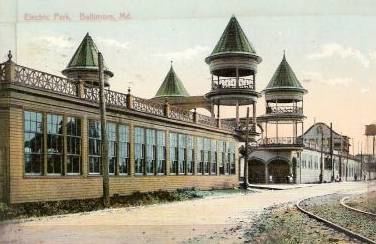 | ||
Electric Park was a name shared by dozens of amusement parks in the United States that were constructed as trolley parks and owned by electric companies and streetcar companies. After 1903, the success of Coney Island inspired a proliferation of parks named Luna Park and Electric Park, while the World's Columbian Exposition of 1893 inspired the formation of White City amusement parks at roughly the same time. The existence of most of these parks was generally brief: the bulk of them closed by 1917, the year of the U.S. entry into World War I. Many pavilions have outlasted the parks themselves, with a few of them still standing today.
Contents
Electric Parks
The emergence of trolley parks in the last dozen years of the 19th century coincided with the rise to prominence of three entities: the electric companies (which grew rapidly as much of the United States was undergoing electrification since the 1880s), the railway companies (which constructed new interurban rail lines mainly in the eastern half of the U. S.), and - starting about 1890 - the replacement of horse-drawn cars by electric trolley companies. A fourth contributor to the rise in amusement parks in the first decade of the 20th century was the success of Coney Island, which spurred the establishment of dozens of Electric Parks, Luna Parks, and White City amusement parks (the latter actually inspired by White City in the 1893 World's Columbian Exhibition in Chicago), with many metropolitan areas having two (or more) parks with these names.
Most Electric Parks were owned by electric companies and trolley companies, which often had one or more lines that transported workers and shoppers between the downtown areas of the various cities and residential and industrial areas. (After 1900, interurban electric rail lines began carrying commuters from one city to another). Originally, the trolleys and interurban lines would either operate at a reduced level on weekends or be completely idle. To generate weekend traffic, the companies eventually created new destinations, generally at the end of their lines, for the public to attend on the weekends, whether it be a picnic park or (later) an amusement park. Regardless of the type of park, the destinations owned by the local electric company or accessed by the electric trolley were commonly called electric parks. After 1903, Luna Park in Coney Island's success (with the park's entrance decked with electric lights) inspired the creation of Electric Parks, which spread throughout North America (at the same time, the similarly-inspired Frederick Ingersoll started to construct his Luna Park empire).
Like their Luna Park and White City cousins, a typical Electric Park featured a shoot-the-chutes and lagoon, a roller coaster (usually a figure eight or a mountain railway), a midway, a Ferris wheel, games, and a pavilion. Most also had miniature railroads. Many cities had two (or all three) of the Electric Park/Luna Park/White City triumvirate in their vicinity... with each trying to outdo the others with new attractions, with many incorporating an exhibit simulating the Johnstown Flood of 1889. The competition was fierce, often driving the electric parks out of business with increasing costs of equipment upgrades, upkeep, and insurance. More than a few succumbed to fire. As a result, most were out of business by 1917, the year the United States entered World War I. By the time troops returned to the U.S. (in 1919), almost all the Electric Parks were gone.
List of Electric Parks
While the date and location of the first Electric Park is currently unknown, several existed before 1900. Since then, dozens of amusement parks had acquired the name:
